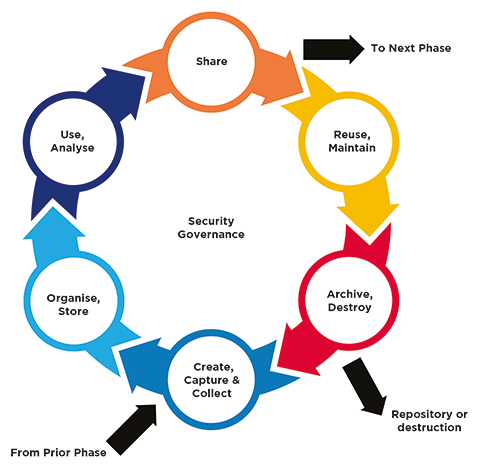

A lot of people seem to be talking about archival and retention processes these days. Or am I just taking note of it more because I like the subject? Because in truth, if I zoom in on all the projects I’ve been a part of, I feel like it’s the other way around: the subject is apparently below the radar of many organizations I know. It deserves a lot more attention than it gets. For all kinds of reasons.

☝️ DLM is the process of managing documents and data in their entire lifecycle from creation to archival/destruction. But I’m specifically talking today about the last part of that: archiving and destroying data.
So I’d like to poke the fire a bit: data lifecycle management, retention, compliance, it’s a hugely important subject! And its benefits are hugely underrated as well. So let’s look at four positive side effects of implementing data lifecycle management:
🕵️ 1. What isn’t there cannot be lost or stolen
From a security and governance perspective, the case for data lifecycle management is clear: The larger your data estate, the more data you have to protect. And the more data that can be lost or stolen, maybe even without someone finding out about it.
I’m reminded of a large migration project that I was a part of. While analyzing the source data we found a data leak where a fired employee had taken a lot of documents with him as he left the company. Nobody had noticed. This could have been prevented with better governance policies in place. But the data had just grown and grown beyond the point where it was manageable.
It’s easy to lose track of things if there’s too much of it! And it’s far harder to protect it all.
💸 2. What isn’t there doesn’t cost money to store
As organizations have been embracing working in the cloud, we’ve increasingly been hearing questions from IT professionals about their tenant running out of space! With Microsoft 365 and SharePoint, this is not typically a question you think about when you’re migrating from your File System. All we hear is that with the cloud there are no limits. And that’s mostly true… if you have enough money.
The amount of available storage space on SharePoint for an organization is calculated based on the amount of user licenses you have. It’s currently 1 Tb per tenant + 10 Gb per user license. The cost of buying additional storage space on SharePoint is quite high though. A good reason to take every precaution to be lean and mean!
This can be done in various ways. For example by something simple as limiting the amount of versions a document may have in SharePoint. But more so by taking care beforehand what data is archived and destroyed and when. Implementing retention policies and retention labels are a great way to do this, as well as moving data to cold storage if possible.
🔎 3. Finding what you need is easier
The more data you have, the harder it is to find what you need. This is a simple fact. It’s the reason why we have search engines. And Microsoft Search is a prime example of those: a very powerful tool. But it cannot work miracles. Even with search engines it’s easy to get lost in the search results. It’s clear as cake here: it’s a good thing for everyone if there’s less irrelevant data. To keep around what you really need and destroy content that’s expired.
With the dawn of AI and Microsoft Copilot we’re seeing a new era of search. Copilot can help you draw together information from various sources and present it in a meaningful way. It’s a great tool! And it has possibilities here in terms of ignoring stale data. But the same applies here as well: Even Copilot will benefit from clear Governance policies and data lifecycle management.
⏰ 4. Postponing will make it harder
Last, but not least: the longer you wait, the harder it will become to implement data lifecycle management. It’s a bit like cleaning your house. The longer you wait, the more work it will be. It all starts with a good information architecture. Once you have that in place, you shouldn’t stop, but take the next step and implement retention policies and/or retention labels. In the end, taking the necessary steps upfront will save you a lot of time and money in the long run, and it will lead to better data quality and thus happier users.
Conclusion
These are just four reasons to start implementing data lifecycle management right away. But there’s probably many more. Let’s not wait until the data has grown above your head. Let’s start now and make sure we’re in control of our data. It’s a good thing for everyone.
Happy compliance journey!
purview dlm retention sharepoint
More
More blogs

Applying inactive retention labels
In this blog post I'm highlighting the difference between active and inactive retention labels, and why you may want to keep your retention labels as inactive.
Read more
Daisy-chaining retention labels and automated archival
An partner-post with Joanne C. Klein on how to automatically move files labelled with a Purview retention label to some archive location.
Read more
Automating Purview data retention using Azure Functions
An example of how to automatically apply Purview retention labels using Azure Functions.
Read moreThanks
Thanks for reading

Thanks for reading my blog, I hope you got what you came for. Blogs of others have been super important during my work. This site is me returning the favor. If you read anything you do not understand because I failed to clarify it enough, please drop me a post using my socials.
Warm regards,
Martin
Microsoft MVP | Microsoft 365 Architect